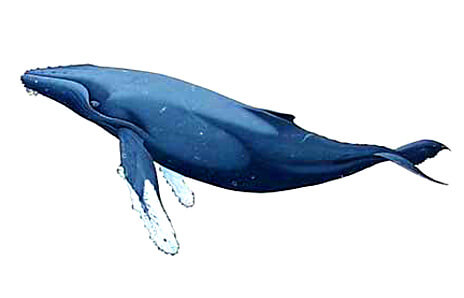
Humpback Whale
Visitor from the South, the Humpback Whale
The humpback whale is an inter-oceanic creature that lives throughout all major salt water bodies of the earth. About 80,000 humpbacks are divided between 18,000 and 20,000 in the North Pacific, roughly 20,000 in the North Atlantic and approximately 50,000 roaming the Southern Hemisphere. Migrating up to 25,000 kilometers (16,000 miles) each year, the humpback only feeds for about 120 days in the summer in arctic waters on small fish and krill filtered through their baleen filters.

This large whale of 12 to 16 meters (39 to 52 feet), and weighing 36,000 kilograms (39.5 tons), has two physical features distinguishing it from other whales. It possesses a hump in front of its small dorsal fin and the humpback has long flippers that are often slapped on the water’s surface. Female humpbacks are usually larger than males.
Humpbacks have grooves that run from their chin to their navel, which let their throat expand to take in water while they’re feeding. About 330 pairs of baleen plates filter up to 2,000 to 2,500 kilograms (4,400 to 5,500 pounds) of krill and plankton on each summer day of feeding. Bubble nets spread in a circle by a pod of diving humpbacks trap their schools of prey, enabling the whales to swim through their bubble-corral and enjoy a big meal.
Breaching, or jumping out of the water, is a favorite activity of a humpback. They are known to stick their tail out of the water and slap the water’s surface. Humpbacks also vocalize with complex songs in warm waters, but turn to basic groans and scrapes in arctic waters, when they’re concentrating on eating.
An average life of 45 to 50 years is expected of a humpback whale. Some are thought to live as long as 80 years. Humpback calves are born every two to four years in tropical waters.
It’s estimated that over 200,000 humpback whales were commercially hunted in the 1900s until there were only 5,000 left worldwide in 1966, when the International Whaling Commission banned the commercial hunting of humpback whales. That ban is enforced to this day. Greenland’s native inhabitants are allowed to take humpback whales for substance purposes.